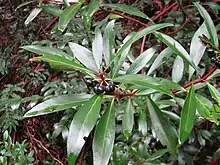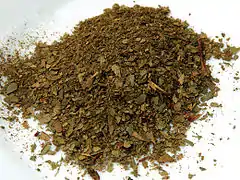Tasmannia lanceolata
Tasmannia lanceolata (syn. Drimys lanceolata), commonly known as Tasmanian pepperberry or mountain pepper,[1] is a shrub native to woodlands and cool temperate rainforest of south-eastern Australia. The shrub varies from 2–10 metres (6.6–32.8 ft) high. The aromatic leaves are lanceolate to narrow-elliptic or oblanceolate, 4–12 cm long, and 0.7–2.0 cm wide, with a distinctly pale undersurface. Stems are quite red in colour. The small cream or white flowers appear in summer and are followed by black, globose, two-lobed berries 5–8 mm wide, which appear in autumn.[2][3][4] There are separate male and female plants.[5]
| Tasmannia lanceolata | |
|---|---|
 | |
| Scientific classification | |
| Kingdom: | Plantae |
| Clade: | Tracheophytes |
| Clade: | Angiosperms |
| Clade: | Magnoliids |
| Order: | Canellales |
| Family: | Winteraceae |
| Genus: | Tasmannia |
| Species: | T. lanceolata |
| Binomial name | |
| Tasmannia lanceolata | |
| Synonyms | |
Originally described by French botanist Jean Louis Marie Poiret, it gained its current name in 1969 by A.C. Smith. It had been known for many years as Drimys lanceolata.
It is found in Tasmania and northwards through Victoria to Barrington Tops in New South Wales. It is found in gullies in rainforests.[6]
Uses
Polygodial has been identified as the primary active compound in Tasmannia lanceolata, and is also responsible for its peppery taste. The fruits also contain benzoic acids, flavanols, and flavanones, as well as eugenol, methyl eugenol, and gallic acid, and also the glycosides quercetin and rutin.[7]
The leaf and berry have long been used as a spice, typically dried. The 1889 book The Useful Native Plants of Australia records that common names included "Pepper Tree" and that "the drupe is used as a condiment, being a fair substitute for pepper, or rather allspice [...] The leaves and bark also have a hot, biting, cinnamon-like taste."[8]
More recently, it has become popularised as a bushfood condiment. It can be added to curries, cheeses, and alcoholic beverages. It is exported to Japan to flavour wasabi. The berries are sweet and fruity at first with a lingering peppery aftertaste.[5] Dried T. lanceolata berries and leaves have strong antimicrobial activity against food spoilage organisms. It also has high antioxidant activity.[9] Low safrole clonal selections are grown in plantations for commercial use, as safrole is considered a low-risk toxin.[10]
Used in colonial medicine as a substitute for Winter's bark,[11] a stomachic, it was also used for treating scurvy.[12] Tasmanian pepper is one of a number of native Australian herbs and food species being supported by the Australian Native Food Industry Ltd, which brings together producers of food species from all parts of Australia.[13] The pepperberry can be used as a fish poison.[5]
It can be grown as an ornamental garden plant. Its berries attract birds,[14] including currawongs, that feed on them.[5] It can be propagated from cuttings or seed, and can grow in a well-drained acidic soil with some shade, but is sensitive to Phytophthora cinnamomi.[5]
Garden cultivars include 'Mt. Wellington', a compact plant with coppery new growth,[15] and 'Suzette', a variegated cultivar.[16]
References
- "Tasmannia lanceolata". RHS. Retrieved 5 March 2021.
- Beadle, N.C.W., Evans, O.D., Carolin, R.C., Flora of the Sydney Region, A.H. & A.W. Reed, 1976, ISBN 0-589-07086-X
- "PlantNET - FloraOnline". plantnet.rbgsyd.nsw.gov.au. Retrieved 11 October 2018.
- Floyd, A.G., Rainforest Trees of Mainland South-eastern Australia, Inkata Press, 1989, ISBN 0-909605-57-2
- Department of Primary Industries, Parks, Water and Environment. "Tasmannia lanceolata" (PDF). Department of Primary Industries, Parks, Water and Environment website. Tasmanian Government. Retrieved 2009-08-13.
{{cite web}}: CS1 maint: multiple names: authors list (link) - Fairley A, Moore P (2000). Native Plants of the Sydney District:An Identification Guide (2nd ed.). Kenthurst, NSW: Kangaroo Press. pp. 52–53. ISBN 978-0-7318-1031-4.
- Cock, Ian (2013). "The Phytochemistry and Chemotherapeutic Potential of Tasmannia lanceolata (Tasmanian Pepper): A Review" (PDF). Pharmacognosy Communications. Retrieved 25 January 2022.
- J. H. Maiden (1889). The useful native plants of Australia : Including Tasmania. Turner and Henderson, Sydney.
- Zhao, J.; Agboola, S. (2007). "Functional Properties of Australian Bushfoods - A Report for the Rural Industries Research and Development Corporation" (PDF). RIRDC Publication No 07/030. Archived from the original (PDF) on 2009-09-21. Retrieved 2009-08-13.
- Menary, R.C., Drager, V.A., Garland, S.A., Tasmannia lanceolata - Developing a New Commercial Flavour Product, Rural Industries and Development Corporation, 1999.
- Maiden, J.H., The Useful Native Plants of Australia, Turner & Henderson, Sydney, 1889
- Ewart, A.J., Flora of Victoria, Melbourne University Press, Melbourne, 1930.
- "Australian Native Food and Botanicalsu". Anfil.org.au. Archived from the original on 31 July 2019. Retrieved 11 October 2018.
- "Fact Sheet: PLANT DIARY: Tasmannia lanceolata". Gardening Australia Website. Australian Broadcasting Corporation. April 5, 2002. Retrieved 2009-08-12.
- "Cally Gardens plant list". Archived from the original on 2 July 2009. Retrieved 25 January 2022.
- "Plant profile, Bluebell Arboretum and Nursery". Bluebellnursey.com. Archived from the original on 6 March 2016. Retrieved 25 January 2022.
External links
- Bruneteau, Jean-Paul, Tukka, Real Australian Food, ISBN 0-207-18966-8
- "Tasmannia lanceolata". Australian Plant Name Index (APNI), IBIS database. Centre for Plant Biodiversity Research, Australian Government.

